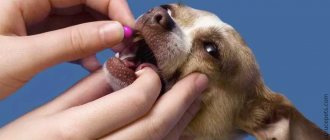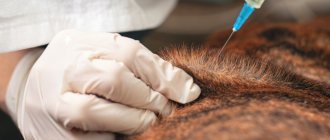How often dog owners suffer when their pets get sick! And the disease may not be serious, and it can be cured in a few days if you persuade your four-legged friend to take the medications and vitamins prescribed by the veterinarian. It would seem that what is so difficult about this? Have you ever tried giving a dog a pill?
And it doesn’t matter at all whether we are talking about a puppy or an adult dog - they simply extract tablets from sausage, from candy, from almost any treat and spit them out!
Do you remember how in everyone’s favorite film “Operation Y and Shurik’s Other Adventures” the character A. Demyanenko tried to feed sleeping pills to the dog, “hiding” them in the “Doctor’s” sausage? Do you remember what came of it? And this is not a director’s invention at all! Dog owners know that their pets actually do this with all pills! So what to do?
How to give a pill to a dog?
Experts who know dogs - dog handlers, advise giving pills to a dog in such a way as not to scare it, otherwise it will remember the time when you ran after it or tried to give the pill by force, and will never want to take the medicine.
Attention. Before giving the tablet to your dog, consult a veterinarian, read the instructions, and find out whether it can be crushed or mixed with food, since there are medications that cannot be washed down with anything other than water, and even when exposed to air they lose their properties.
There are several ways you can give a pill to a dog without stressing it:
- Place the tablet on your tongue
- Hide in food
- Crush and give with food
- Dissolve the tablet and give it to the dog using a regular syringe.
- Give the whole tablet using a special syringe
You need to give the pill to your dog in this order:
Pharmacological properties
Veracol in any form of release has the same effect on the dog’s body:
- relieves inflammation in the gastrointestinal tract, normalizes intestinal peristalsis (contraction), disturbed by infection or parasites;
- relieves muscle spasms accompanied by aching pain;
- restores the condition of the intestinal mucosa after prolonged diarrhea;
- promotes the healing of wounds and ulcers on the walls of the stomach and intestines;
- restores the tissue barrier of the digestive system organs, damaged due to bacterial infections;
- normalizes the secretion of intestinal glands;
- stops the growth and development of staphylococci and streptococci, which is especially important when treating puppies, for whom not every antibiotic is suitable;
- helps restore impaired liver function.
How to properly give a whole tablet to a dog's tongue?
To give a tablet to a dog's tongue, first of all, you need to open its mouth. How to do this if your pet doesn’t want to open? People involved in breeding dogs are advised to act in the following sequence:
- Decisively, and at the same time, gently speaking to the dog, we press with two fingers on the gap between the rows of teeth, and the dog itself will open its mouth.
- Quickly place the tablet on the tongue as far as possible.
- We lift the dog's head up and scratch its neck, so it will swallow the pill.
- Then we praise the dog, give him water to drink, and if the tablet can be taken with food, give him something tasty that he likes.
Attention. This option is suitable if the tablet is bitter because there are no taste buds at the base of the tongue and the dog will not immediately notice the bitterness.
If the procedure with the tablet did not work out the first time, try again.
Attention. If the tablet is in a gelatin capsule, it can be lubricated with vegetable oil so that it does not stick to the teeth, gums, palate, and for better passage through the throat.
You can give a pill to a dog if you talk to it calmly
You might be interested
How to give an intramuscular or subcutaneous injection to a dog without errors or harm
Intramuscular or subcutaneous injections may be needed when treating a dog for a tick bite, chronic diseases, ...read more
Deworming dogs before vaccination - when is it necessary and how is it done?
When you decide to have a cute four-legged hulk in your home, then, in order to avoid many ...read more
Dog vaccination - description and vaccination schedule
Why do children decide to get a puppy so quickly, and why do parents take so long and persistently...read more
How allergies manifest themselves in dogs - causes and treatment methods
Along with protection, food and a permanent place of residence, domestic animals often also acquire diseases...read more
What vitamins do puppies need - canine vitamin deficiency
Not only people, but also their beloved pets need useful vitamin supplements. You need to watch…read more
How to properly give a tablet to a dog's tongue using an introducer?
If the dog is aggressive and you need to give it a pill, but you are afraid that you will be left without fingers, then you can buy a special syringe called an introducer . This tool has a rubber tip where a tablet or half or quarter is placed, and the whole thing is inserted into the dog's mouth. By pressing the plunger of the syringe, the tablet is moved to the base of the dog's tongue. And the dog will have no choice but to swallow the pill.
Attention. The introducer is also good because it works “2 in one”: you can fill it with water, put a tablet on the tip, and first give the dog the tablet and then the water.
This is what the introducer looks like with a tablet clamped in the tip
Briefly about the main thing
- For treatment to have a positive result, the dog must take the medications correctly. Every owner should know how to administer therapeutic agents into the animal's body.
- Tablets can be added to food if permitted by the instructions.
- Forced administration of the drug is allowed if it is not possible to give the medicine otherwise; the main thing is to act confidently, but carefully.
- For manipulation, you can use an Introducer; thanks to this device, you can easily place the product on the tip of your four-legged friend’s tongue.
- If you need to give the drug in liquid form, it is recommended to use a dispenser.
Have we answered your question fully enough? If not, post your question in the comments below and our veterinarian will answer it.
Did you like the article? Share it with your friends on social media. networks. This will help them get useful information and support our project.
What is the correct way to give a whole tablet to a dog with food?
It is advisable to give your dog a tablet with food in the following cases:
- If the dog is aggressive and bites
- Someone else's dog that you are temporarily caring for
- If you couldn’t put the tablet on your dog’s tongue by hand
- If the medicine can be given with food
In order for the dog to eat the pill, you need to push it deeper into a piece of meat, cheese or other food, and make sure that he swallows everything along with the pill.
Some dog lovers advise placing the tablet on a small piece of bread and greasing it with a thick layer of butter; there should be enough butter so that the tablet is not visible. Then call the dog, but do not give it a sandwich right away, but on command, after some time, and when you allow it to eat, it will swallow it with pleasure and will not feel the pill.
Attention. If the dog leaves the pill and eats the food, then this option is not suitable for you, you need to look for the next one.
In the famous film "Operation Y" and Shurik's other adventures, Shurik tried to give pills to a dog with sausage, but nothing came of it.
If it gets bad
The drug has a minimum of contraindications and can be prescribed to animals of different ages and conditions.
Side effects are extremely rare. However, in some cases the following phenomena are possible:
- arrhythmia;
- a sharp decrease in pressure;
- depression of the respiratory center.
In the most severe cases, collapses were noted. Side effects mainly occur when the drug is administered intravenously, so such injections are practically not used.
Although the drug has low toxicity, it can be dangerous for dogs.
An overdose of the drug can cause nausea and vomiting, depression, loss of appetite or short-term convulsions. In this case, specific treatment is not required - usually the symptoms go away on their own after 1-2 days.
In some cases, an allergic reaction is possible. If its signs are noted, the drug is stopped. To mitigate the effect of the medication, anticholinergics can be used. They are indicated in the treatment of stomach or duodenal ulcers.
How to properly give a crushed tablet to a dog with food?
If the dog eats all your offerings in the bowl, but leaves the tablet untouched, then you can crush the tablet and mix it with thick or liquid (for example, kefir) food. To make the tablet dissolve better, liquid food or water is slightly heated and the tablet is dissolved in it.
Attention. Not all tablets can be mixed with food, but only those taken with meals.
Please note that deworming tablets most often cannot be taken with any dairy products.
Some dogs are very sensitive to the taste or smell that they have been drugged and refuse to eat such food with a tablet, then you need to come up with another way to give the tablet to the dog.
You can give crushed tablets to your dog with food.
Compound and liquid medicines
Sometimes you may choose a flavored medicinal product or a chewable “treat.” This works well for dogs that don't like to swallow pills.
However, these medications can be more expensive - depending on the drug - and your veterinarian may caution against mixing certain medications as this may affect their effectiveness.
Also, medications cannot always be found in every pharmacy. Ask your veterinarian to refer you to pharmacies that are known for compounding medications.
How to properly give a tablet dissolved in water to a dog?
If the dog does not want to eat the whole or crushed tablet, then the medicine can be dissolved in water or ask the veterinarian to prescribe a liquid medicine. It's easier to give it to a dog. To give a dissolved tablet to a dog, proceed as follows:
- We draw the medicine into a regular syringe
- We insert a syringe without a needle into the dog’s mouth, from the side between the teeth.
- Slowly release the medicine from the syringe, making sure that it does not flow out, but into the dog’s throat.
You can give a tablet dissolved in water to a dog using a syringe without a needle.
General information
Worm infestation is a painful condition in which the dog constantly loses strength. Parasites feed on the body's resources: blood and tissues, and after digesting food, they release waste products - toxins. The more worms multiply in a dog’s body, the faster his health deteriorates.
In addition, there are parasites that grow to 0.4–1.5 meters in length , which can cause damage and blockage of the intestines. Some worms, as larvae, enter the bloodstream and settle in the liver, pancreas, heart, eyes or brain of the animal. Timely prevention and compliance with precautionary measures significantly reduces the risk of infection, but does not guarantee their absence.
Any owner can significantly reduce the risk of worm infection by:
- Avoid feeding raw meat , only boiled or frozen.
- River fish and especially shellfish. Dogs can eat low-fat ocean fish, but it must be boiled or deep-frozen.
- Raise your dog so that it does not pick up leftover food from the ground.
- Monitor the vitamin content of the diet, since if there is an imbalance, many four-legged animals have a desire to eat soil or feces.
- Plant grass for your dog so that he doesn't have to look for vegetation outside.
- Buy products that have passed veterinary control.
- Observe personal hygiene and prevention standards, since you can bring eggs or larvae of worms from public places.
A dog infected with worms becomes a carrier and can infect other animals and even people. By the way, a person can also infect a dog, so do not forget about prevention for yourself. Be sure to anthelmintize a puppy before vaccination or an adult dog before revaccination. Worm infestation greatly suppresses the immune system, and vaccination is a weakened virus. The vaccine should promote the production of antibodies, but if the immune system is weakened, vaccination can provoke the development of the disease.
What should you not do when giving a pill to your dog?
To give a pill to a dog and have it eat it, you need to behave correctly with it. What should you not do with your dog?
- You should not get the instructions for using the medicine, the medicine itself and the syringes in front of the dog, otherwise you may scare him and he will not want to eat the pill.
- If you want the dog to open its mouth, you cannot shout at it, chase after it, or hurt it when opening its mouth, otherwise it will resist and may bite you, and with your behavior you can forever discourage it from taking medicine.
- You should not give pills to a dog when the animal is aggressive.
- If you give your dog tablets after a meal, you should not feed him a lot of food before, otherwise he may vomit everything, including the tablet.
- Tablets should not be diluted in milk.
So, if you were unable to give the pill to your dog using any of the above methods, do not despair, ask your veterinarian to prescribe an injection for you, and invite a nurse to your home and she will give the dog an injection, or come to the medical facility with your dog.
Basic mistakes
The main mistake of pet owners is the desire to force the dog to eat medicine by any means. This method will not give the desired result and will harm the pet. He will experience severe stress and will remember all the actions of the owner that caused him discomfort. As a result, he will associate the pills only with unpleasant sensations. For this reason, you should not force your dog to eat drugs.
A pet can use the product on its own only if it has a pleasant taste and is easy to chew. In particular, these are drugs from Bravecto. These are flea and tick medications. Even a puppy can use it. The main thing is to use the medicine if the pet’s weight exceeds 2 kg.
Another mistake owners make is that they add products to food or drink, despite the instructions. Such therapy will not be effective. In addition, unpleasant consequences for the dog’s body may occur. To prevent this from happening, medications can only be taken in accordance with the instructions and recommendations of the veterinarian.
In addition, some owners of four-legged friends, faced with difficulties, refuse therapy. This is the most serious mistake that can lead to unpredictable consequences. Refusal of treatment even leads to the death of the pet. For this reason, the dog must take the medicine without fail, no matter how difficult it may be.
What you need to remember when starting the procedure
- Prepare everything you need in advance (remove the tablet, divide it into parts if necessary). During a long course of treatment, it is advisable to carry out these manipulations unnoticed by the pet.
- Keep calm. Animals sense the state of their owner very subtly.
- After each manipulation, monitor your pet for several minutes. Some animals manage to spit out the medicine.
- If the procedure at home does not work, you can consult a veterinarian about changing the form of the drug (rectal suppositories, injections, ointments).
- Encourage and praise your pet after each manipulation.











